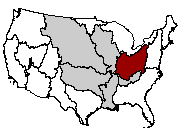Globally, the riverine export of carbon (C) is estimated to be ~0.8 Pg yr-1 (Pg = 1015 g) which is ~13% of annual fossil fuel emission. The riverine C flux includes fluxes of organic, inorganic, and particulate carbons. Among these fluxes, riverine organic and inorganic C fluxes are estimated to be ~0.4 Pg-C yr-1 each, and dissolved inorganic carbon (DIC) flux is the main focus of this study. The major form of the DIC in most rivers is bicarbonate, which is produced by the weathering of silicates and carbonates within a watershed. Human induced land-use change could affect watershed bicarbonate generation and export by altering regional climate, changing water flow paths, shifting dominant plant species, and adding more weatherable minerals such as agricultural lime.
 We are currently investigating the effects of land use change on stream water chemistry in the Ohio River Basin which contributes the largest discharge to the Mississippi River. The land use land cover of the Ohio River Basin estimated by the Landsat TM (Thematic Mapper) imagery (circa 1992) demonstrated that forest and agriculture were by far the two most dominant land use types in 1992, covering 51.1% and 42.7% of the Ohio River Basin respectively. Spatiotemporal analysis on the land use effects are being conducted using USGS water quality data, climate data, and historic census data.
We are currently investigating the effects of land use change on stream water chemistry in the Ohio River Basin which contributes the largest discharge to the Mississippi River. The land use land cover of the Ohio River Basin estimated by the Landsat TM (Thematic Mapper) imagery (circa 1992) demonstrated that forest and agriculture were by far the two most dominant land use types in 1992, covering 51.1% and 42.7% of the Ohio River Basin respectively. Spatiotemporal analysis on the land use effects are being conducted using USGS water quality data, climate data, and historic census data.
 |
| The land use of Ohio River Basin which contributes the largest discharge to the Mississippi River. The Mississippi River Basin is presented as grey area and the Ohio River Basin in red area in the top figure. The two dominant land uses of the Ohio River Watershed were forest (51.1%) and agriculture (42.7%) in 1992 estimated by Landsat TM imagery. |
